Viking Weapons
The Vikings were Scandinavians
who colonized parts of Europe from the 9th to the
11th century. Vikings revered the sword above all
weapons. The passing of a family sword from father
to son was considered a major event. Even better was
the knowledge that a sword had been wielded in
battle or in a feud by a great warrior or nobleman.
This gave the sword added status and was thought to
imbue the blade with special powers. The Viking
armory also included the spear and battle-axe, the
first-line weapons launched against an enemy.
Viking Weapons
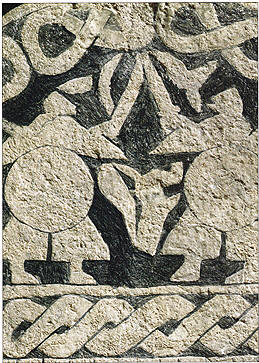 The
main Viking battlefield weapons employed during
first contact with the enemy were the spear and
battle-axe. One of the reasons why the sword usually
took a secondary role in the initial phase of a
battle was that the continual striking of one sword
edge against another would have inflicted large
nicks to the blade and eventually removed the
consistency and effectiveness of its finely
sharpened edge. The
main Viking battlefield weapons employed during
first contact with the enemy were the spear and
battle-axe. One of the reasons why the sword usually
took a secondary role in the initial phase of a
battle was that the continual striking of one sword
edge against another would have inflicted large
nicks to the blade and eventually removed the
consistency and effectiveness of its finely
sharpened edge.
Because of this, once the spear or axe had done its
work, the Viking warrior would then draw his sword
and look for exposed and softer areas of the body to
attack. Skeletons of Viking battlefield victims
unearthed by archaeologists consistently exhibit
more spear wounds than sword cuts, highlighting the
selective use of Viking swords in battle.
RIGHT:
A
9th-century Viking-decorated stone carving from
Gotland, Sweden, depicts two soldiers fighting with
swords.

ABOVE:
A
Viking sword from the 10th century with lobed
pommel. The wide, double-edged blade would have made
it a very powerful weapon.
The Viking
Spear
A Viking warrior’s most common battlefield weapon,
the spear, comprised a simple iron, broad-leafed or
spiked point on a wooden (normally ash) shaft, with
a total length of around 1—2m (3.2—6.5ft).
Spearheads with wings were called barbed spears. The
spear was extremely effective and used for both
thrusting and throwing, with larger-headed spears
being used for cutting. There is evidence that the
spears used to cut through chainmail were used
one-handed as well as two-handed. A skilled Viking
spearman was reputed to be able to throw two spears
at once, using both hands, and also to catch a spear
in flight and hurl it back at the opposition. A
sword was then used in close-combat fighting.
Pommels
and Scabbards
The Viking sword pommel (located at the end of the
hilt) is one of the most distinctive characteristics
of a Viking sword. Most pommels were cast in solid
iron (its weight providing a counterbalance to the
weight of the blade), but there are also fine
examples in bronze and also of iron inlaid with
sheets of silver. Pommels ranged from the early
pyramidal shapes of
C.AD800
to the later, more complex pommels that were formed
from triangular segments.
The great artistry and imagination of the Viking
metalworker is clearly evident in these pommels and
cross guards, with complex interlaced and geometric
patterns worked in both silver and bronze gilt.
A scabbard (sheath or case) was made of two carved
pieces of wood, glued at the sides and sometimes
covered in leather or fur. The mouth and chape (the
metal plate at the point) of the scabbard were
sometimes mounted with decorated silver or bronze
gilt. The sword would have been carried using a
baldric (waist or shoulder belt).
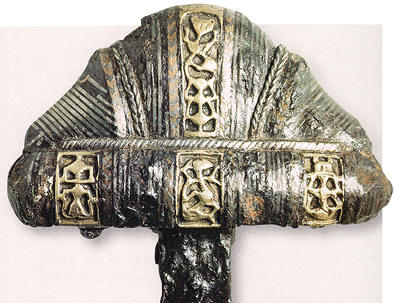
ABOVE:
A Viking sword hilt with a cocked hat or lobed
pommel. The decoration includes stamped abstract
cartouches.
The Viking
Battle-axe
When wielded with appropriate
force, the Danish long-handled or “bearded”
battle-axe was a devastating weapon. Its design was
based on domestic Viking wood-splitting axes found
throughout Scandinavia during the Viking period and
evolved for use in battle. The battle-axe had a much
larger head of either crescent or convex shape,
which favoured downward blows, with a long wooden
haft measuring l—2m (3.2—6.5ft) in length. Sometimes
blades were forged with an especially hardened
double edge. They could also be forged quite thinly
to give the user a lighter, more easily handled
weapon.

ABOVE:
A large two-handed Viking bearded war axe with
socketed metal head fitted to a wooden handle.
Underneath is a Viking socketed spearhead, probably
from the 10th century, which would have been fitted
to a wooden shaft.
The Viking Sword
About 70—80cm (27.5—31.5in) long, the wide,
double-edged blade of a Viking sword had shallow
fullers, or so-called “blood grooves”. The grooves
were not actually designed to allow the blood to run
down easily but rather to reduce the weight of the
blade and give it added flexibility. The Vikings had
a very close relationship with their swords, borne
out by the personalized names they gave them,
including Gramr (“Fierce”), Fotbitr (“Leg-biter”)
and Meofainn (Decorated down the middle”). Swords
were not common or inexpensive weapons and it is
likely that they were mainly carried by persons of
rank and wealth.
Viking Sword
Manufacture
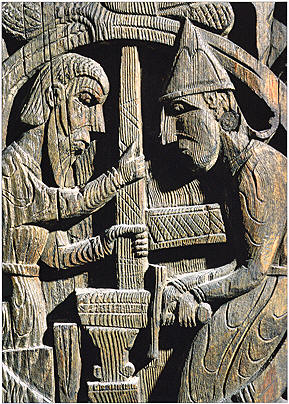 The
smelting of iron ore with carbon to produce fine
steel was well known to the Vikings and contributed
to their reputation for producing blades of superb
quality. They are best known for the complex process
of pattern welding employed in their manufacture.
Modern X-ray technology of surviving blades now
enables us to see how Viking smiths produced
patterned blades by welding long strips of iron and
steel together, forging them into square rods then
finally twisting or folding these rods into small
bunches, so creating the hard inner core of the
blade. The outer cutting edge of the blade was
welded to this inner core, using the best steel.
Finally, the blade was carefully ground and polished
with acid to reveal the extensive patterning. The
smelting of iron ore with carbon to produce fine
steel was well known to the Vikings and contributed
to their reputation for producing blades of superb
quality. They are best known for the complex process
of pattern welding employed in their manufacture.
Modern X-ray technology of surviving blades now
enables us to see how Viking smiths produced
patterned blades by welding long strips of iron and
steel together, forging them into square rods then
finally twisting or folding these rods into small
bunches, so creating the hard inner core of the
blade. The outer cutting edge of the blade was
welded to this inner core, using the best steel.
Finally, the blade was carefully ground and polished
with acid to reveal the extensive patterning.
Smiths worked hard to produce
their own distinctive patterns. Their pride in such
skilled work resulted in many blades being engraved
with their makers’ names, notably “Ulbehrt’
“Lunvelit” and “Ingelri”.
RIGHT:
A
12th-century carving from a wood panel in a church
in Setesdal, Norway, depicts a scene from the Norse
legend of Sigurd (Siegfried). Here, the dwarf Regin
and his helper are shown forging a sword on an
anvil.
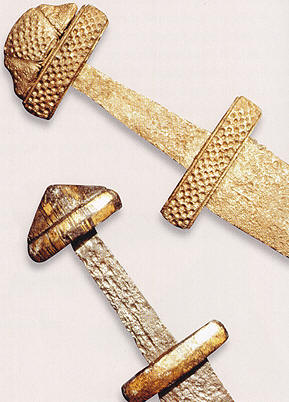 Viking
Sword Duels Viking
Sword Duels
The Vikings engaged in formal duels, or holmganga,
to settle feuds. Holmganga roughly translates as
“island going” and indicates that most duels took
place on small islands where limitations of space
(and, consequently, options for retreat), could be
strictly enforced. The area of combat was determined
by the laying out of a square cloth. Furrows were
marked out around the cloth and the space was
enclosed by a rope. Each of the combatants was
allowed a second whose role was to hold the
warrior’s shield. Swords were the weapon of choice.
The duel did not commence with both warriors rushing
at each other. Instead, each man took his turn at
making one strike against his opponent. If a
combatant chose this opportunity to back off and in
so doing placed his foot outside the cloth, he was
deemed to have run away and the fight would be
stopped. If a strike was effective and
incapacitating, the wounded party was allowed to
stop the fight but was then obliged to forfeit a sum
of money to his winning opponent.
ABOVE:
Two swords that display the distinctive punched and
geometric
decoration that was common on Viking sword pommels.
Orkneyinga Saga
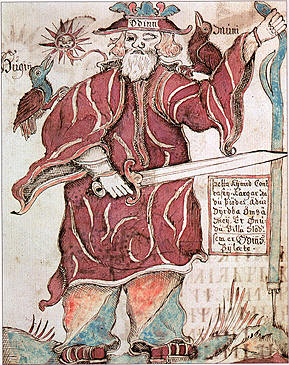 Settling
a feud by single combat with swords is a common
theme in Viking sagas. One of the most famous
accounts of the bloody use of a sword in such a feud
is retold in the
Orkneyinga Saga
(c.1200), a unique historical narrative of the
Orkney Islands that covers the period from its
capture by Norwegians in the 9th century until the
early 1 200s. Settling
a feud by single combat with swords is a common
theme in Viking sagas. One of the most famous
accounts of the bloody use of a sword in such a feud
is retold in the
Orkneyinga Saga
(c.1200), a unique historical narrative of the
Orkney Islands that covers the period from its
capture by Norwegians in the 9th century until the
early 1 200s.
The saga recounts how Rognvald, a Norwegian
chieftain who ruled Orkney in
c.
A0860, was burnt to death in his own home by two of
Harald Fairhair’s sons. Bent on revenge, Rognvald’s
son Einar struck down and killed one of Harald
Fairhair’s sons, Halfdan Halegga. The victim’s body
was found the next day on the side of a hill, and
the shape of an eagle had been cut into his back
with a sword. More gruesomely, the ribs had been
removed from the backbone and his lungs splayed out
to represent the eagle’s wings. Einar believed this
display a worthy sacrifice to the Norse war god,
Odin.
RIGHT:
The Norse god Odin with his sword and two ravens. He
was the god of war and battle and the bringer of
victory.
The Sword in
Viking Sagas
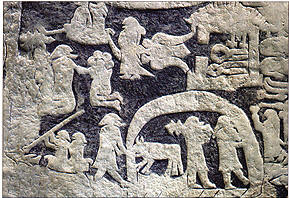 The
Vikings were great storytellers and believed that
recounting tales was a gift, handed to them by the
all- powerful war god, Odin. Without any means of
writing them down, the Viking storytellers or skalds
prided themselves on recalling epic stories and
passing them on to others. Through these tales, the
Vikings ensured that details of their religious
beliefs and adventures were passed on from one
generation to the next. Skalds were often employed
by kings who wanted to be revered throughout their
kingdoms. Although the stories were likely to have
been exaggerated by the skalds, there is probably
some truth in their telling of the events that
occurred. The
Vikings were great storytellers and believed that
recounting tales was a gift, handed to them by the
all- powerful war god, Odin. Without any means of
writing them down, the Viking storytellers or skalds
prided themselves on recalling epic stories and
passing them on to others. Through these tales, the
Vikings ensured that details of their religious
beliefs and adventures were passed on from one
generation to the next. Skalds were often employed
by kings who wanted to be revered throughout their
kingdoms. Although the stories were likely to have
been exaggerated by the skalds, there is probably
some truth in their telling of the events that
occurred.
ABOVE:
A detail from a stone carving from Gotland
representing Valhalla, the great hall of the god
Odin. Here warriors enjoyed a glorious afterlife
awaiting the final battle against the forces of
evil.
The ancient sagas of both the
Vikings and the Anglo-Saxons frequently refer to the
great strength of a sword blade and its apparent
capability to hew a man in two. Sword strokes were
aimed primarily at the head and neck, and were
calculated to be killing blows. The following
description from a later Icelandic text, describing
events in the 10th and 11th centuries, underlines
the devastating effect of a single sword blow:
Then Thorbjorn rushed
upon Grettir and struck at him, but he parried
it with the buckler in his left hand and struck
with his sword a blow which severed Thorbjorn’s
shield in two and went into his head, reaching
the brain... from Grettir’s Saga (c.1400)
|